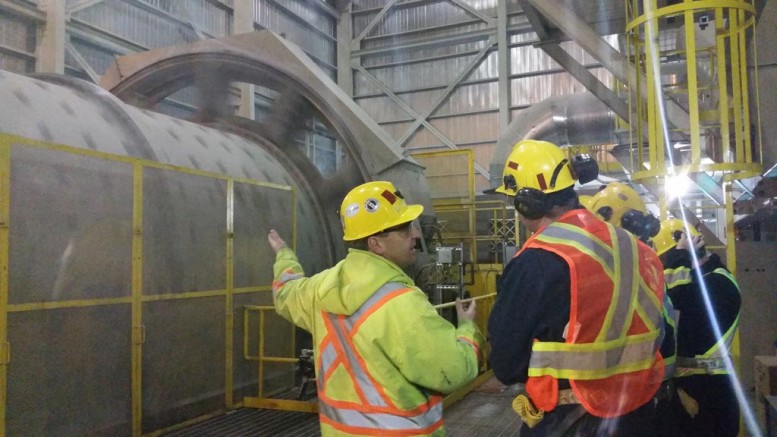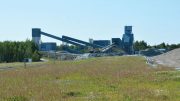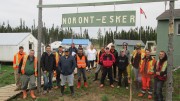Ontario is the largest mineral-producing province by value in Canada. Last year the province produced $10.1 billion in minerals, or 21.4% of Canada’s $47-billion worth of mineral production. It also has an active exploration scene, with about 150 companies actively exploring more than 200 projects. Here is a look at eight companies with mines and exploration projects in the province.
Argonaut Gold

An aerial view of Argonaut Gold’s Magino gold propery in Ontario, located 40 km northeast of Wawa. Credit: Argonaut Gold.
Argonaut Gold (TSX: AR) wholly owns the advanced-stage Magino gold project, 40 km northeast of Wawa, Ontario.
The company acquired the open-pit project in December 2012 and completed a feasibility study in November 2017. The study outlines production of 116,000 oz. gold per year over a 17-year mine life (including three years of ore processed from a low-grade stockpile) for total production of nearly 2 million oz. gold at cash costs of US$669 per oz., and all-in sustaining costs (AISCs) of US$711 per ounce.
The study estimated initial capex of US$321 million and an after-tax payback period of just under four years at a gold price of US$1,250 per ounce. At a base case, 10,000-tonne-per-day processing rate, Magino’s after-tax net present value, at a 5% discount rate, was pegged at US$288 million, with a 19.5% post-tax internal rate of return.
Magino’s measured and indicated resources stand at 144 million tonnes grading 0.91 gram gold per tonne for 4.20 million contained oz. gold, and another 33.2 million inferred tonnes averaging 0.83 gram gold for 886,000 contained oz. gold.
Earlier this year, the federal government issued a positive decision on the project’s environmental assessment. Magino still requires provincial government approval and other key authorizations, such as a construction permit and mine closure plan.
Canada Cobalt Works

Frank Basa (left), CEO of Canada Cobalt Works, and Robert Allender Jr., Nevada Sunrise Gold’s designated Qualified Person, at the Lovelock cobalt property in Nevada, where Global Energy Metals can earn up to an 85% stake. Credit: Global Energy Metals.
Canada Cobalt Works (TSXV: CCW) wholly owns the Castle mine project in northern Ontario’s historic cobalt camp. The project contains the past-producing Castle mine and its adjoining 78 sq. km land package, northeast of the town of Gowganda. The mine operated at various times between 1917 and 1989, producing a total of 9.41 million oz. silver and 376,053 lb. cobalt from the No. 3 shaft.
The company has permitted access to underground workings and results from underground drilling, bulk and chip samples have run as high as 5.2% cobalt, 5.3% nickel, 13,208 grams silver per tonne and 10.1 grams gold. The junior is also drilling a discovery 1.5 km east of the mine, and plans to process historic tailings.
In addition, Canada Cobalt Works says it has shown in lab tests that it can produce a battery-grade cobalt sulphate using its Re-20X metallurgical process, with feed from Castle, and recently signed a strategic technology initiative with Global Energy Metals that allows GEM to test Re-2OX on mineralized material from its Lovelock cobalt mine and Treasure Box projects in Nevada. The technology skips the normal smelting process and allows recoveries of cobalt, nickel, copper and manganese, while removing arsenic from the product.
First Mining Gold

The camp at First Mining Gold’s Springpole gold project, 110 km northeast of Red Lake, Ontario. Credit: First Mining Gold.
First Mining Gold (TSX: FF; US-OTC: FFMGF) has four projects in Ontario: Springpole, Goldlund, Cameron and Pickle Crow.
Springpole, 110 km northeast of the town of Red Lake, is one of Canada’s largest undeveloped gold projects, with 4.67 million contained oz. gold and 24.19 million oz. silver in the indicated category (139.1 million tonnes grading 1.04 grams gold per tonne and 5.4 grams silver per tonne), and inferred resources of 230,000 oz. gold and 1.12 million oz. silver (11.4 million tonnes grading 0.63 gram gold and 3.1 grams silver). A preliminary economic assessment (PEA) completed in September 2017 outlined a mine life of 12 years. At full production, the open-pit operation would produce 296,500 oz. gold and 1.63 million oz. silver per year at cash costs of US$619 per equivalent oz. gold and AISCs of US$806 per equivalent oz. gold.
Its advanced-stage Goldlund project, 60 km northeast of Dryden, contains 809,200 oz. gold (12.86 million tonnes grading 1.96 grams gold) in the indicated category, and another 876,954 oz. gold (18.36 million tonnes grading 1.49 grams gold) in the inferred.
Cameron, 80 km southeast of Kenora, contains 5.53 million measured and indicated tonnes grading 2.61 grams gold for 464,000 contained oz. gold, and 6.54 million inferred tonnes averaging 2.54 grams gold for 533,000 oz. gold.
Pickle Crow, formerly a high-grade mine operating until the 1960s, is near the township of Pickle Lake, and contains inferred resources of 9.5 million tonnes grading 4.1 grams gold for 1.23 million contained oz. gold.
Harte Gold

Harte Gold’s Sugar Zone gold mine in northern Ontario. Credit: Harte Gold.
Harte Gold (TSX: HRT; US-OTC: HRTFF) is Ontario’s newest gold producer. It declared commercial production in January at its Sugar Zone mine, 80 km east of the Hemlo gold camp and 24 km north of White River. The underground operation is the province’s first mine built in over a decade.
The mine has indicated resources of 4.24 million tonnes grading 8.12 grams gold per tonne for 1.11 million contained oz. gold and another 2.95 million inferred tonnes averaging 5.88 grams gold for 558,000 oz. gold.
A feasibility study in April 2019 outlined annual production of 61,000 oz. gold over a 14-year mine life at 800 tonnes per day.
In the second quarter, the mine produced 7,754 oz. gold, a 4% quarter-over-quarter increase, at an average head grade of 6.01 grams gold per tonne. Cash costs were US$1,070 per oz. and AISCs were US$1,734 per ounce.
Exploration on the 793 sq. km Sugar Zone property continues to make discoveries.
The company closed a US$82.5-million financing with BNP Paribas in June.
Elsewhere in Ontario, Harte Gold owns the Stoughton–Abitibi property in the Timmins gold camp.
Frontier Lithium

Frontier Lithium Inc.’s VP Exploration Garth Drever (left) and President & CEO Trevor R. Walker examine core from the PAK lithium deposit in northwestern Ontario, representing 155 metres of world-class, technical grade, low-iron spodumene. Credit: Frontier Lithium Inc.
Frontier Lithium (TSXV: FL) is advancing its PAK lithium deposit in northwestern Ontario’s emerging Electric Avenue lithium district, 175 km north of Red Lake. The Pak deposit contains 5.77 million proven and probable tonnes grading 2% lithium oxide across a potential open-pit and underground operation. The resource remains open at depth as well as along strike to the northwest and southeast.
According to a 2018 prefeasibility study, the project would generate $700 million in after-tax cash flow across a 16-year mine life — 11.5 years of open-pit mining followed by 4.5 years of underground mining. It has a $301 million after-tax net present value at an 8% discount rate and a 38.3% after-tax internal rate of return.
A mine at PAK would produce a total of 1.14 million tonnes of technical-grade concentrate at 7.2% lithium oxide and 115,500 tonnes of chemical-grade concentrate at 6.6% lithium oxide for $147 million in pre-production capital, and $37 million in sustaining capital.
Late last year the company discovered the Spark pegmatite, 2 km northwest of the PAK deposit. It cut eight channels ranging from 11 metres to 79 metres in length. In total, it sampled 236 metres at an average grade of 1.91% lithium oxide and kicked off a 1,340-metre drill campaign earlier this year to determine the orientation and thickness of the pegmatite.
Kirkland Lake Gold

Kirkland Lake Gold’s Holloway headframe in Matheson, Ontario. Credit: Kirkland Lake Gold.
Kirkland Lake Gold’s (TSX: KL; NYSE: KL) flagship asset in Ontario is the Macassa underground mine in the town of Kirkland Lake, 580 km north of Toronto. The mine remains one of the highest-grade gold mines in the world. Last year, it produced 240,126 oz. gold, in line with its guidance of 220,000 to 250,000 oz. gold. It processed a total of 354,469 tonnes at an average grade of 21.6 grams gold per tonne.
The company also owns the Taylor, Holloway, Holt and Hislop mines, and a mill facility at Holt, in Matheson, Ontario. Last year the Holt mine produced 67,770 oz. gold, in line with the company’s full-year guidance of 65,000 to 75,000 oz. gold. (The Holt mine was originally built and operated by Barrick in the late 1980s.) Its newest mine, Taylor, which started commercial production in the fourth quarter of 2015, produced 58,633 oz. gold in 2018. Ore from Taylor is processed at the Holt mill.
This year, production at Macassa, Holt and Taylor is expected to be similar to 2018 levels. The company’s Holloway mine, which resumed operations in February 2019, after being on care and maintenance since December 2016, is expected to contribute 20,000 oz. gold. Over the next five to seven years, the company plans to boost production at Macassa to over 400,000 oz. gold a year.
Underground drilling at Macassa continues to generate encouraging results in support of future growth in resources and reserves, the company says, while drilling at Taylor targets expansion of mineralization around the Shaft and West Porphyry deposits.
Pure Gold Mining

Pure Gold Mining VP of exploration Phil Smerchanski near a portal during test mining at the Madsen gold project in Ontario. Credit: Pure Gold MIning.
Pure Gold Mining’s Madsen gold project is in Red Lake, Ontario. In August, the company secured a US$90-million project financing with Sprott Resources that will fully fund the initial capital costs (US$71 million) to develop the underground mine, and the company plans to pour first gold before the end of 2020.
Based on a 2019 feasibility study, the underground operation will produce an average of 79,000 oz. gold annually over 12 years at a processing rate of 800 tonnes per day.
The company expects life-of-mine capital costs of $327 million, including pre-production and closing costs. The study pegged cash costs at US$607 per oz. gold, with AISCs of US$787 per oz. gold. Assuming gold prices of US$1,275 or US$1,400 per oz., Madsen has an after-tax net present value of $247 million or $326 million, and a 36% or 45% internal rate of return.
As a past production site, the project doesn’t need an environmental assessment, Pure Gold says, and the property already has several permits, although some will need amendments based on the company’s development plan.
Madsen is on the Red Lake greenstone belt — a prolific host of orogenic gold deposits — and has a resource of 7.2 million indicated tonnes grading 8.9 grams gold per tonne, for 2.06 million contained oz. gold. There is another 467,000 oz. gold in 1.88 million inferred tonnes grading 7.7 grams gold.
The company recently reached a framework agreement with local First Nations in July, and raised $47.5 million in private placements.
Wesdome Gold Mines

Pit operations at Wesdome Gold Mines’ Mishi gold mine in northern Ontario. Photo by Alisha Hiyate.
Wesdome Gold Mines’ (TSX: WDO) Eagle River mine complex near Wawa in northern Ontario consists of the Eagle River underground mine and the Mishi open-pit mine, which feed a central mill. Last year, the complex produced 71,625 oz. gold, a 21% increase from 2017, and generated $2.8 million in free cash flow. This year the company forecasts production of 72,000 to 80,000 oz. gold, primarily from the Eagle River mine.
Eagle River, 60 km southeast of Hemlo and 50 km west of Wawa, has operated for 25 years and produced over 1 million oz. gold.
This year, the company has budgeted $6.9 million for exploration at Eagle River, where five drill rigs will undertake 51,000 metres of underground definition drilling and another 43,000 metres of underground exploration.
The company also owns the Moss Lake property in the Shebandowan greenstone belt, 100 km west of Thunder Bay. The Moss Lake gold deposit is a large-tonnage, low-grade deposit amenable to open-pit mining. It contains indicated resources of 39.8 million tonnes grading 1.1 grams gold per tonne for 1.4 million oz. gold, and inferred resources of 50.4 million tonnes at the same grade for 1.75 million contained oz. gold.
The company has no debt and $27.4 million in cash at the end of the second quarter. Revenue from its Eagle River operation this year funds $27-million worth of exploration and development work at its Kiena gold project in Val-d’Or, Que., which has been on care and maintenance since mid-2013, and is being explored for a restart.





Be the first to comment on "Ontario Snapshot: Eight companies with Ontario mines and exploration projects"